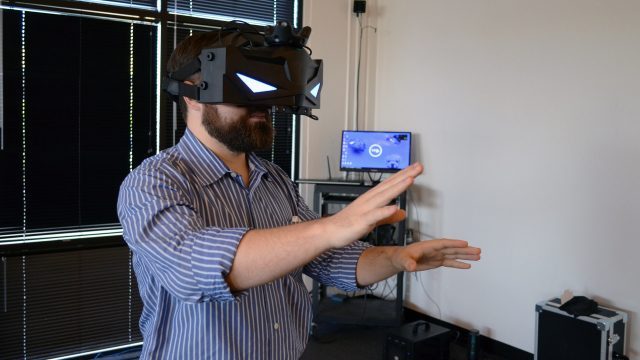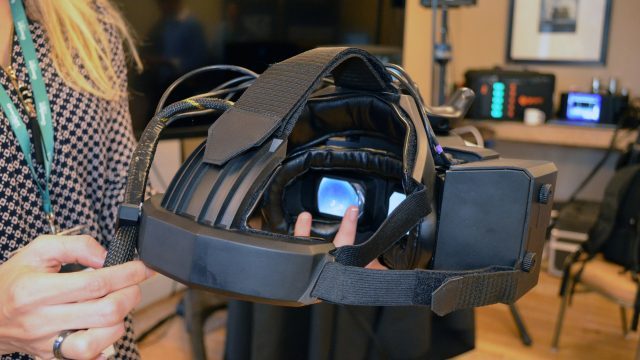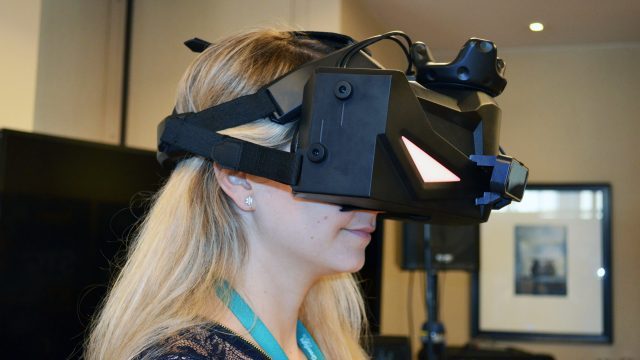VRgineers is a Czech-based startup building a VR headset positioned strictly for the enterprise world. Compared to today’s consumer VR headsets, it’s undeniably huge and heavy, but a hands-on with their latest VRHero “5K” Plus shows that they’re on a path to delivering on their promise of unmatched image quality.
You may have heard the VRgineers name before; the company debuted their initial enterprise-focused VRHero “5K” headset last year. Still under ongoing development, the new VRHero “5K” Plus brings a range of improvements that show a positive development trajectory for the headset, including an upgrade from LCD to OLED displays, improved lenses, and better SteamVR Tracking and latency thanks to sensors fusion (with a Vive Tracker), ‘direct mode’, reprojection, and low persistence.

First a quick note: we’re putting the “5K” part of the headset’s name in quotes because it doesn’t refer to the same 5K that would come to mind for most of us when thinking of TVs or monitors. While the headset’s total horizontal resolution is indeed 5,120 pixels, that’s split across one 2,560 wide display per eye, while the vertical resolution is just 1,440, not the 2,880 or so that would accompany a 5K TV or computer monitor.
We think this is confusing if not misleading, so we put “5K” in quotes to help our readers understand that it’s being used in a way that’s different than they would otherwise expect. It’s a shame really, to be distracted by the use of “5K” in the name, because the headset’s visual clarity really does impress.
And one final note, some of the pictures in this article show the slightly older version of the headset, though both use the same external design.
VRHero “5K” Plus
With that said, the VRHero “5K” Plus is rocking a pair of 2,560 × 1,440 OLED displays running at 70Hz. For comparison, the Rift and Vive use two 1,080 × 1,200 displays (@90Hz), while the Samsung Odyssey and Vive Pro use two 1,440 × 1,600 displays (@90Hz). So the VRHero’s displays are higher resolution than the former, and wider than the latter.
That gives the headset a very wide field of view—150–170 degrees by VRgineers’ measure. Its custom non-Fresnel optics offer quite astonishing clarity, likely the best I’ve seen from any modern headset not using microdisplays.

Individual pixels in the VRHero “5K” Plus are exceeding difficult to pick out (though you can glimpse clumps of them), sub-pixels are all but invisible, and the screen door appeared on the verge of vanishing. This isn’t retina resolution just yet, but it’s close enough for me to imagine what that’s going to look like when we get there.
Since this isn’t a Fresnel lens, I didn’t see any of the common ‘god rays’ during high contrast scenes, and chromatic aberration was very minimal (though that depends somewhat on the IPD setting).
While they’re not exactly positioned as competitors (as Pimax is aiming for consumers, and VRgineers for enterprise), the overall image clarity from the VRHero was notably better than what I’ve seen from the Pimax “8K,” despite the “8K” using higher resolution displays (3,840 × 2,160 per display, vs. 2,560 × 1,440), which is a bit counterintuitive. I asked VRgineers why they thought this might be the case; they say that image clarity is their number one priority, and so they selected the best components to maximize visual quality across the entire pixel to photon pipeline.
For one, they said that nothing is being downsampled; the demos I was looking at were running on a $1,200 NVIDIA Titan Xp GPU, which they say was cranking out 2,560 × 1,440 frames at 70Hz, per eye. Inside the headset, they’ve got the right components to handle that bandwidth without degrading image quality, the company told me. And then of course there’s the lenses, which VRgineers said were custom made for the headset and tuned for clarity, even at the expense of weight and other factors. Another advantage for image clarity would be that the VRHero “5K” has a somewhat smaller field of view than the Pimax “8K”, which means it sacrifices a bit of image size for increased pixel density.
As for tracking, the headset’s enterprise focus means that VRgineers expects professional tracking systems to be attached to the headset, but the company has also built support for SteamVR Tracking via a Vive Tracker. This has been recently improved compared to older implementations thanks to sensor fusion between the Vive Tracker and the headset’s internal sensors. Latency isn’t perfect just yet, but it’s solid enough.
The Perfect Headset? Not So Fast.

So if you stopped reading right now, you might walk away thinking that the VRHero “5K” Plus is the best headset out there—after all, it’s got incredible image clarity, right? Well, yes, and if you’re looking for visual fidelity above all else, it could fit the bill. But no single factor makes a VR headset great; if your interest in VR hinges around Presence (the feeling of truly ‘being there’), you’ll want to look elsewhere for the best experience. VRgineers have had to compromise on many aspects of the headset to achieve its impressive image quality; many of those factors become bottlenecks of Presence long before the image quality is called into question.

The VRHero “5K” Plus is absolutely huge, so big that it feels like it belongs on an arm-mount by your desk side more so than resting on your head. And sure, it’s relatively “balanced”, but it’s so heavy that turning your head in any direction feels unnatural (especially tilting your head far up or down). The headset with its counterbalanced weight clocks in at 1.08kg, more than twice the weight of the Rift or Vive, or the equivalent of about 30 pairs of sunglasses—not to mention it’s much larger in volume, which further increases its rotational inertia (the effort needed to start and stop rotation of the headset).
Inside the headset things look great when you’re moving your head slowly (or keeping it still) but it’s hard to stay deeply immersed from one moment to the next when you’re moving so much extra weight around with every turn of your head.
There’s a number of other caveats too. While VRHero’s field of view was very wide (much wider than you’d expect from the likes of the Rift, Vive, PSVR and others), and mostly very sharp, the view in the headset is ‘display limited’ rather than ‘lens limited’, meaning the lenses had a somewhat wider field of view than the displays; by not filling the entire field of view of the lenses, there’s some gains in image quality, but you give up some immersion because the sharp edge of the display seems less natural than the soft vignetted edges of other headsets.
With the OLED displays at 70Hz, there was some visible ghosting against high contrast elements. Furthermore, there was distracting blurring at the left and right of the field of view, similar to what I saw with the Pimax “8K” at CES 2018, but not quite as intense (and none at the top and bottom). I also seemed to have some trouble with stereo-fusion, which means it didn’t feel entirely natural to align the images from each of my eyes into a coherent 3D image. Even after fiddling with the VRHero’s independent IPD and focus adjustments, I couldn’t get it to feel quite right—that feeling where your eyes ‘relax’ into their usual comfortable way of seeing.
Part of that trouble is likely related to the headset’s distortion profile not being spot on yet (which renders the scene in a way that accounts for the lenses’ inherent distortions), but another issue could be the canted displays (a common factor between the “5K” Plus and the Pimax “8K,” which gave me similar stereo-fusion trouble), which are angled with respect to each other.







